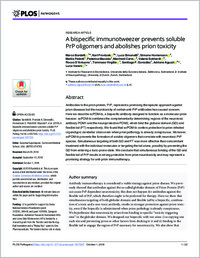A bispecific immunotweezer prevents soluble PrP oligomers and abolishes prion toxicity
- Bardelli, Marco Institute for Research in Biomedicine (IRB), Faculty of Biomedical Sciences, Università della Svizzera italiana, Switzerland
- Frontzek, Karl Institute of Neuropathology, University of Zurich, Zurich, Switzerland
- Simonelli, Luca Institute for Research in Biomedicine (IRB), Faculty of Biomedical Sciences, Università della Svizzera italiana, Switzerland
- Hornemann, Simone Institute of Neuropathology, University of Zurich, Zurich, Switzerland
- Pedotti, Mattia Institute for Research in Biomedicine (IRB), Faculty of Biomedical Sciences, Università della Svizzera italiana, Switzerland
- Mazzola, Federica Institute for Research in Biomedicine (IRB), Faculty of Biomedical Sciences, Università della Svizzera italiana, Switzerland
- Carta, Manfredi Institute of Neuropathology, University of Zurich, Zurich, Switzerland
- Eckhardt, Valeria Institute of Neuropathology, University of Zurich, Zurich, Switzerland
- D’Antuono, Rocco Institute for Research in Biomedicine (IRB), Faculty of Biomedical Sciences, Università della Svizzera italiana, Switzerland
- Virgilio, Tommaso Institute for Research in Biomedicine (IRB), Faculty of Biomedical Sciences, Università della Svizzera italiana, Switzerland
- González, Santiago F. Institute for Research in Biomedicine (IRB), Faculty of Biomedical Sciences, Università della Svizzera italiana, Switzerland
- Aguzzi, Adriano Institute of Neuropathology, University of Zurich, Zurich, Switzerland
- Varani, Luca Institute for Research in Biomedicine (IRB), Faculty of Biomedical Sciences, Università della Svizzera italiana, Switzerland
-
01.10.2018
Published in:
- Plos pathogens. - 2018, vol. 14, no. 10, p. e1007335
English
Antibodies to the prion protein, PrP, represent a promising therapeutic approach against prion diseases but the neurotoxicity of certain anti-PrP antibodies has caused concern. Here we describe scPOM-bi, a bispecific antibody designed to function as a molecular prion tweezer. scPOM-bi combines the complementarity-determining regions of the neurotoxic antibody POM1 and the neuroprotective POM2, which bind the globular domain (GD) and flexible tail (FT) respectively. We found that scPOM-bi confers protection to prion-infected organotypic cerebellar slices even when prion pathology is already conspicuous. Moreover, scPOM-bi prevents the formation of soluble oligomers that correlate with neurotoxic PrP species. Simultaneous targeting of both GD and FT was more effective than concomitant treatment with the individual molecules or targeting the tail alone, possibly by preventing the GD from entering a toxic-prone state. We conclude that simultaneous binding of the GD and flexible tail of PrP results in strong protection from prion neurotoxicity and may represent a promising strategy for anti-prion immunotherapy.
- Language
-
- English
- Classification
- Medicine
- License
- Open access status
- gold
- Identifiers
-
- RERO DOC 326625
- DOI 10.1371/journal.ppat.1007335
- ARK ark:/12658/srd1318891
- Persistent URL
- https://n2t.net/ark:/12658/srd1318891
Statistics
Document views: 207
File downloads:
- Texte intégral: 200
